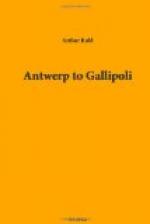All the young men had gone to the front—their wages continued as usual —and the work was carried on by women and old servitors, scarcely one of the latter under seventy. They were pointed out as examples of the beneficent effect of the true cognac—these old boys who had inhaled the slightly pungent fragrance of the cellars and bottling-rooms all their lives. You get this perfume all over Cognac. It comes wandering down old alleyways, out from under dark arches, people live literally in a fine mist of it. The very stones are turned black by the faint fumes.
There must be scores of towns south of Paris which look more or less like this—the young men gone or drilling in the neighborhood, the schools turned into hospitals, the little old provincial hotels sheltering families fled from Paris. There are several such at our hotel, nice, comfortable people—you might think you were in some semi-summer-resort hotel at home—Ridgefield, Conn., for instance, in winter time.
The making of cognac occupies nearly every one, one way or another, and it has made the place next to the richest town of its size in France. They make the cognac, and they make the bottles for it in a glass factory on a hill overlooking the town—about as airy and pleasant a place for a factory as one could imagine. The molten glass is poured into moulds, the moulds closed—psst! a stream of compressed air turned in, the bottles blown, and there you are—a score or so of them turned out every minute. As we came out of the furnace-room into the chilly afternoon a regiment of reservists tramped in from a practise march in the country. Some were young fellows, wearing uniforms for the first time, apparently; some looked like convalescents drafted back into the army. They took one road and we another, and half an hour later swung down the main street of Cognac behind a chorus of shrilling bugles. All over France, south of Paris, they must be marching like this these frosty afternoons.




